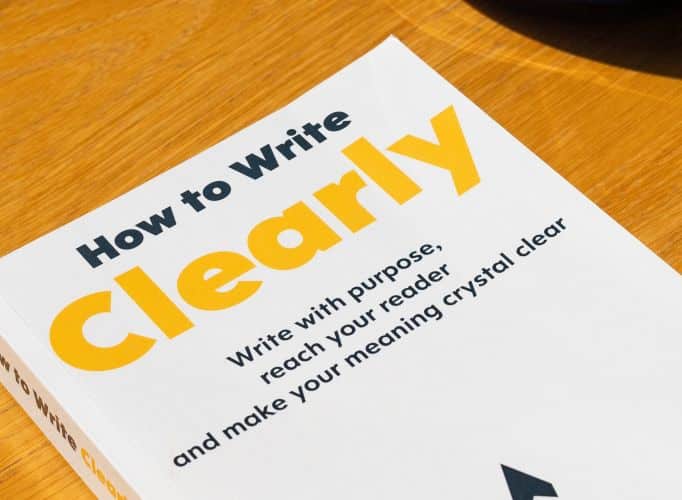When you’re trying to attract your readers’ attention, you need to do so fast. Today, time-poor readers are dealing with information overload from social media, WhatsApp, rolling 24-hour news and more.
How do you keep your reader’s attention on your words?
In this blog, I’ll share with you my 7 top tips for writing clear, concise attention-grabbing content and the pitfalls to avoid.
1. Remove unnecessary words
When I’m editing, one of my first jobs is to scan the copy for unnecessary words like ‘actually’ ‘really’ and ‘quite’. Often these words don’t add anything to the meaning and create unnecessary padding.
Take a look at the following example:
The theatre performance was really good|
Could be rephrased to read:
The theatre performance was captivating
In the original version, the word ‘really’ adds nothing at all. You could replace ‘really good’ with the much more powerful adjective ‘captivating’.
Adverbs like ‘really’ do have a place – particularly in blogs if you’re trying to emphasise a point. But I would use them with caution, particularly in sales content (landing pages on websites and email marketing) where brevity is key.
2. Replace complex words with simpler alternatives
Complex ideas don’t require complex words. In fact, the opposite is true. Plain English helps make the reader’s job easier, particularly if you’re talking about a complicated topic. So, it’s always preferable to use a simpler alternative where possible. Use ‘buy’ rather than ‘make a purchase’ and talk about ‘now’ rather than ‘at the current time’.
These simpler alternatives also sound more conversational than the originals – few people would ever use the phrase ‘with regards to’ in real conversation (unless you’re Jacob Rees-Mogg perhaps).
3. Choose verbs over noun phrases
In many cases, you can create more attention-grabbing content by swapping out noun phrases for verbs.
For example:
It is my intention to explain
would be better phrased as:
I’ll explain
The second option has fewer words but it’s also easier for the reader to understand. Plus, it sounds more conversational and less formal. When I was working in corporate marketing, I used to see this problem a lot. CEOs and Board members often used noun phrases such as “It is my intention to…” to make them sound grand – but it ended up just sounding pompous and old-fashioned. Verb phrases almost always sound more direct and to the point. This will help you write attention-grabbing content.
4. Remove filler words
Filler words include ‘to’, ‘of’ and ‘that’. The word ‘that’ can often be removed without altering the meaning of your sentence.
For example:
The book that I bought yesterday
This could be replaced by:
The book I bought yesterday
In this example, the word ‘that’ just serves to complicate the sentence without fulfilling any useful purpose.
5. Break up long sentences
This is often one of the biggest issues I come across when I’m editing other people’s content: long, convoluted sentences that don’t make sense. Often, you’ve forgotten the original point by the time you’ve reached the end of the sentence.
Long sentences just confuse and complicate your argument. They don’t make for attention-grabbing content. Sentences should be 15-20 words ideally. You can, of course, vary the length of your sentences but avoid running over 20 words if possible. Conjunctions (‘and’ and ‘but’) can be very helpful if you want to break up a sentence, and these days, it’s acceptable to use conjunctions at the start of a sentence.
6. Keep jargon to a minimum
Sometimes, it’s impossible to avoid jargon but use it sparingly. If you’re using lots of jargon that your audience will not understand, this just makes your reader’s job harder – and it’s more likely that they will switch off. Spell out any acronyms or abbreviations that your readers won’t understand.
Of course, if you’re writing a piece for a specific audience of industry specialists and there’s terminology you can’t avoid, then that’s a different story.
7. Be ruthless with your editing
This may sound counterintuitive but it’s much better just to get your ideas down on paper first and edit at a later point. You can easily get yourself tied up in knots trying to fiddle with words you’ve just written and this can interrupt the flow of your writing. You’ll almost certainly come out with higher-quality content if you write your first draft without editing your words and then go back and edit your copy later that day or (even better) the following day (if time allows).
Once you start editing, be ruthless. Read your draft and ask yourself, “Do I really need every single word?” Imagine that you were having to pay for each word – and edit accordingly.
Check that every word contributes to the overall message – are there any redundant words or words that don’t add anything to your argument?
Creating attention-grabbing copy – in summary
I guarantee that, if you follow these simple rules, you’ll be on the right path to writing attention-grabbing content that gets you in front of more readers – and for longer.
If you found this blog useful, you might also be interested in my blog, How to turn boring topics into eye-catching content.
The Plain English Campaign’s website also has lots of useful free resources to help make your writing sharper and more concise.


